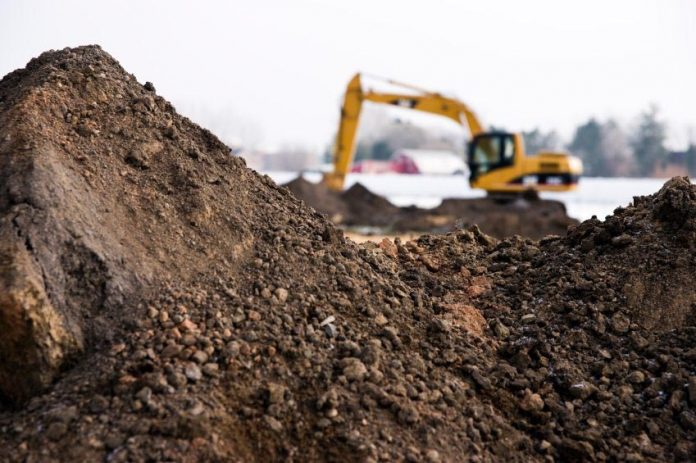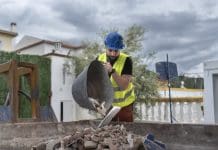Alec Hales, contaminated land specialist at Lucion Services, says new industry guidance provides essential compliance advice for addressing compliance issues with asbestos in soil and construction and demolition materials.
When it comes to identifying and managing the presence of asbestos containing materials (ACMs) in buildings, good information and detailed guidance for construction, health and safety and property professionals has been in existence for some time.
Unfortunately, this has not been the case with asbestos in the ground, despite improvements in practices and approaches in the brownfield development and contaminated land industry.
Now this situation has been properly addressed with the publication of the comprehensive CAR-SOIL guidance which provides authoritative information for working with soil and construction and demolition (C&D) materials that are or may be contaminated with asbestos.
Produced by CL:AIRE on behalf of the Joint Industry Working Group (JIWG) and with the assistance of and endorsement by the Health & Safety Executive, the new document presents a definitive explanation of what is needed for compliance with The Control of Asbestos Regulations 2012 (CAR 2012) and is freely available to download from www.claire.co.uk/asbestos.
When it is determined that asbestos could be present on construction sites, contaminated land or brownfield development sites, it is essential that employers, the self-employed and industry professionals understand how CAR 2102 affects them and what they should do to comply with the law.
To meet this need, CAR-SOIL brings together comprehensive industry guidance on the measures to be taken by the geo-environmental and construction sectors and their duty to ensure that workers and others are not exposed to asbestos as a result of work with soil and C&D materials.
The impact of not suitably reviewing, risk assessing and characterising a site for ACMs might not only significantly increase a project’s duration and cost but can also risk exposing site workers and local residents to such materials.
As you would expect for a document that seeks to improve understanding and knowledge of this very specific sector, some of the most important and fundamental issues to be addressed in the new publication concern competence and training.
Here, unless it has been demonstrated that work will only be carried out on sites that are likely to be free of asbestos, Regulation 10 of CAR 2012 requires that anyone liable to disturb asbestos, or who supervises such employees, should have the correct level of information, instruction and training to enable them to carry out their work safely and competently.
Regarding competence, the new guidance document makes it clear that the potential risks posed by asbestos in soil need to be assessed in accordance with environmental regulations and that the contamination of sites by a potentially wide range of other substances may be an additional important consideration.
Overall competence in relation to the planning regime may also be a factor to satisfy the Local Planning Authority, for example, that any risks from contamination will be appropriately addressed through comprehensive assessment and, if required, remediation.
In general,, CAR-SOIL points out that where employees may potentially disturb asbestos in soil or made ground, specific information, instruction and training will be required which is relevant to the activities being undertaken. Also, it is further recommended that this training should comprise written materials, oral presentation and practical demonstration as necessary.
For example, on asbestos awareness training, the focus of the current provision is on helping employees to avoid exposing themselves and others to asbestos. The principle applies that, if employees know how to identify potential ACMs in the ground, they are then able to stop work and prevent any further disturbance and potential exposure.
CAR-SOIL takes things further, however, and instead recommends that to fully prepare workers on sites that could be potentially contaminated by asbestos, ‘soil-specific’ asbestos awareness training should be provided.
It is proposed that, as well as more general asbestos safety-related topics, this training should include information on the likely types and condition of ACMs that might be encountered in soil and C&D materials, alongside how on-site risks associated with asbestos can be avoided and on the procedures to be followed to deal with any emergency uncontrolled disturbance of asbestos and release of asbestos fibres.
Also, if site work is planned that will necessarily disturb asbestos-contaminated soil and C&D materials, including sampling of soils, further information, special instruction and training appropriate to the work will be needed at a level that goes beyond introductory asbestos awareness. As a minimum, additional non-licensed work (NLW) is required for work that does not require an asbestos licence.
To support the publication of CAR-SOIL, CL:AIRE has also launched a training suite to support workers on site. Further information is available at www.claire.co.uk/asbestos.
The new JIWG guidance provides extensive information on the types of ACMs encountered on brownfield and greenfield sites and clarifies the type of work associated with managing their presence.
Importantly, the guidance also sets out useful definitions and examples of what might be regarded as non-licensed and licensed work, as well as related issues such as short duration work and sporadic and low-intensity exposure (SALI).
To support this explanation, the JIWG has also developed spreadsheet based decision tools available freely online that facilitate the assessment of potential risk and licensing status as part of the risk assessment and Plans of Work provisions set out in and required for compliance under CAR 2012. These may be downloaded at www.claire.co.uk/asbestos-dst.
Overall, in a step-by-step interpretation of CAR 2012, CAR-SOIL provides much needed and definitive guidance that is set in a carefully considered framework.
It has been a long time in the making, but as a result, the construction industry now has comprehensive compliance advice on asbestos in soil and C&D materials issues in the sort of detail that those with asbestos in buildings responsibilities have grown accustomed to.
Lucion Services brings together a group of asbestos surveying and analysis, risk management and construction site safety companies. The company has supported both the CL:AIRE and CIRIA projects in the interests of developing authoritative industry guidance on how the legal requirements of CAR 2012 are interpreted for work with asbestos-contaminated soil and C&D materials. Details can be found at www.lucionservices.com/

Alec Hayles
Contaminated Land Specialist
Lucion Services
Twitter @LucionEnviro











![[VIDEO]What to expect when you’re inspecting: Using DorTrak for fire door inspections](https://www.pbctoday.co.uk/news/wp-content/uploads/2025/02/maxresdefault-218x150.jpg)


